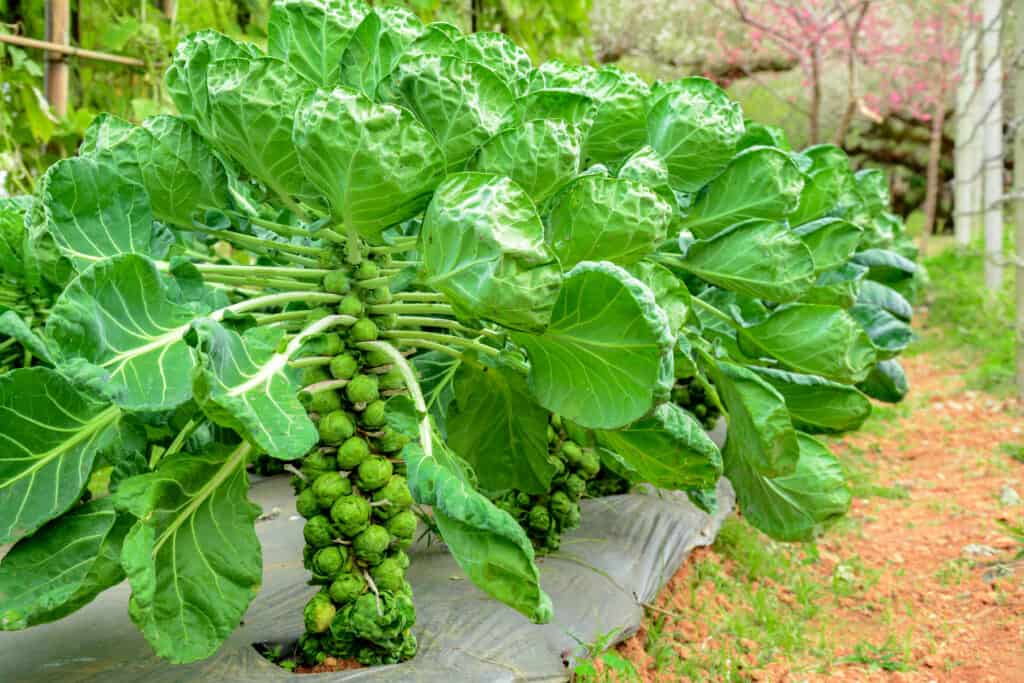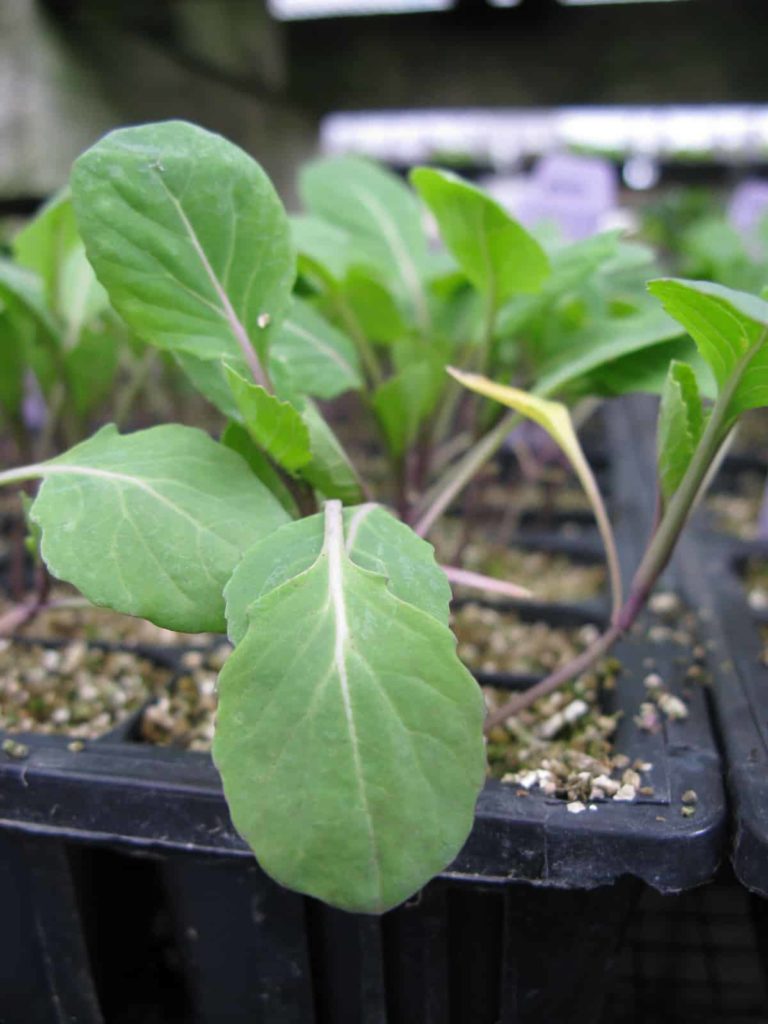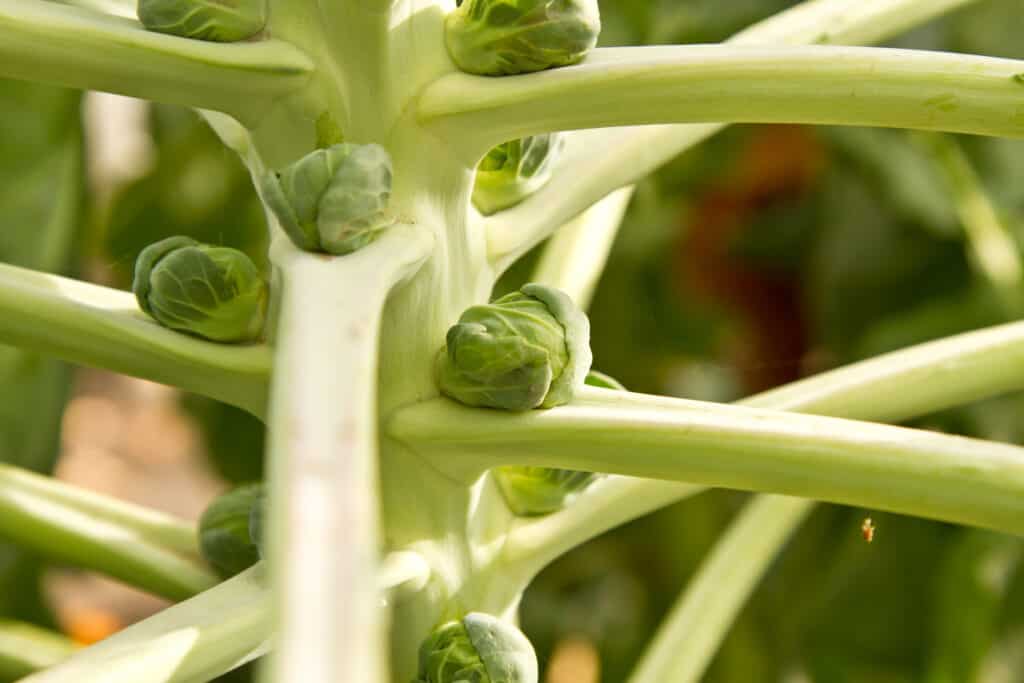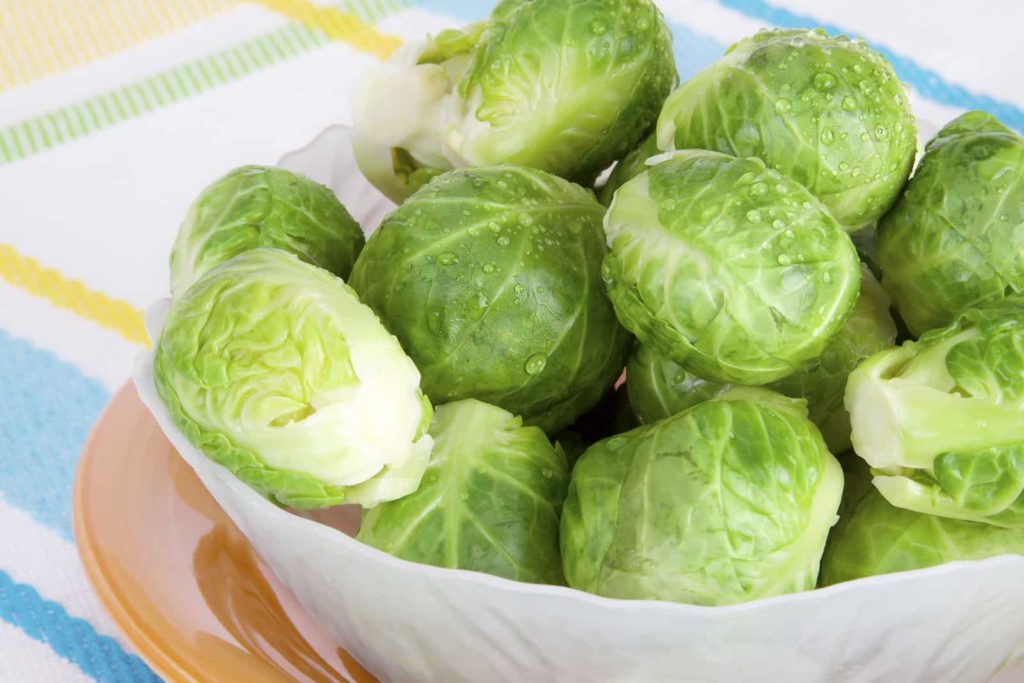Brussels sprouts are best grown in cool weather, usually in early spring or autumn. Sprouts require from 80 to 110 days with daylight temperatures below 80ºF (27ºC) and nighttime temperatures even lower.
Brussels sprouts are frost hardy and will tolerate temperatures as low as 20ºF. A frost will sweeten the flavor of Brussels sprouts. Temperatures that are either too cold or too warm for too long will cause Brussels sprouts to taste bitter. Sprouts that develop in hot weather may not form compact cabbage-like heads. Where winters are mild, Brussels sprouts are best grown in late fall or winter.
Related articles:
- Five Easy Ways to Cook and Serve Brussels Sprouts
- Brussels Sprouts Seed Starting Tips
- How to Harvest and Store Brussels Sprouts
- Brussels Sprouts Growing Problems Troubleshooting

Brussels sprouts–called sprouts by some and thousand-headed cabbage by others–are a peculiar member of the cabbage family. It is an erect, thick single-stalked plant with a leafy top and at the base of the lower leafstalks appear “buttons” or buds that are small, miniature cabbage head-like balls. The sprouts are eaten cooked as a side dish or they can be added to soups, stews, or stir-fries.
Brussels sprouts are leggy plants that grow 30 to 36 inches tall and nearly as wide. The bright green cabbage-shaped sprouts are 1 to 2 inches (2.5-5cm) in diameter. The sprouts are usually closely packed and with no loose leaves.
Brussels sprouts are primarily an autumn cool weather crop. The plant does not mature properly in the heat of summer. Seeds are usually started about 120 days before the first expected fall frost.
Only gardeners with long growing seasons should sow seeds directly in the garden. Brussels sprouts are commonly started indoors. Young plants set in the garden in August and begin bearing in early October. Because Brussels sprouts are fairly resistant to cold weather, the harvest may continue until well after Christmas.
Brussels sprouts are a slow-growing but very bountiful home garden crop. They require a long, cool growing season. Timing is important when planting and growing Brussels sprouts.
Brussels sprouts growing quick tips
- In most regions, plant Brussels sprouts so that they come to harvest in autumn.
- Start seeds indoors 12 to 14 weeks before the first frost in autumn for harvest after the first frost.
- In mild-winter regions plant Brussels sprouts in late summer or autumn for winter or cool spring harvest.
- Brussels sprouts reach maturity 80 to 90 days after transplanting and 100 to 110 days after sowing seed depending on the variety.
- Time planting so that Brussels sprouts do not grow in periods of extended warm weather much above 70°F (21°C). Cool fall weather is ideal for growing Brussels sprouts.
Where to plant Brussels sprouts
Brussels sprouts prefer full sun but will grow in light shade. Brussels sprouts prefer well-worked, well-draining soil rich in organic matter. A sandy loam soil is ideal. Work plenty of compost into the garden before sowing seeds or setting out transplants. Where the soil is sandy, work compost in before planting and side-dress seedlings and plants with compost a couple of times during the growing season. Brussels sprouts grow best in neutral soil with a pH within the 6.5 to 7.5 range.
- Grow Brussels sprouts in full sun, 6 to 8 hours per day.
- Brussels sprouts grow best in fertile soil that is compost-rich, and well-drained soil. Add 6 or more inches (15cm) of aged compost or commercial organic planting mix to planting beds before planting then turn the soil to 12 inches (30cm) deep.
- Heavy soil, not light sandy soil, is best for growing Brussels sprouts.
- Brussels sprouts prefer a soil pH between 6.0 and 6.8. If clubroot disease has been a problem in the past, add lime to adjust the soil to 7.0 or slightly higher.
- Avoid planting Brussels sprouts in the same location two years in a row. Crop rotation is important to prevent soil nutrient depletion and soilborne diseases.

Brussels sprouts planting time
For a spring Brussels sprouts harvest, sow seeds 4 to 6 weeks before the average last frost date in spring or sow directly in the garden 2 weeks before the last frost.
For autumn and winter harvest, sow Brussels sprouts seeds about 90 days before the first frost date. In mild-winter areas, Brussels sprouts can be planted in autumn for winter harvest.
Sow Brussels sprouts seeds from spring to early summer in cold-winter regions; in warm-winter regions, sow from fall to spring. Start seed indoors 8 weeks before transplanting seedlings to the garden. Sow seeds in a warm, well-lighted location—in a bright window or under grow lights. Sow seeds 1/4″ (6 mm) deep in seed starting mix. Firm lightly and keep the mix just moist. Seedlings emerge in 10-21 days at 50-85°F (10-29°C). Sow seed outdoors when the soil temperature is at least 60°F (16°C).
- Plant Brussels sprouts so that they come to harvest in cool weather; the ideal time to harvest Brussels sprouts is in autumn after the first fall frost.
- Brussels sprouts can be planted in early spring for early summer harvest only in regions that have cool summers such as the central coast of California or the Pacific Northwest. In most regions, spring planting is not recommended.
- To determine the best time to plant Brussels sprouts, estimate the date of the first fall frost then count back the number of days to maturity for the variety you are growing; that is the date to set Brussels sprouts transplants in the garden.
- Sow seed directly in the garden 10 to 12 weeks before the first average frost date.
- Time the planting so that harvest comes about 2 weeks after the first frost.
- The best average temperature range for Brussels sprouts growth is 60° to 65°F (15-18°C). Temperatures much above 70°F (21°C) can cause Brussels sprouts to bolt and go to seed.
- Seed sown indoors or in a seed bed outdoors in late May should be ready for transplanting to their permanent place in the garden by the latter part of July or early August.
- Brussels sprouts seedlings are usually available at the garden center mid-summer.
- Brussels sprouts will reach maturity 80 to 90 days after transplanting and 100 to 110 days after seeds are sown.
- Mature Brussels sprouts plants are not suited for temperatures greater than 80°F (26°C); sustained warm temperatures will leave Brussels sprouts bitter-tasting and may cause their tight cabbage-like heads to open.
More tips: Planting Brussels Sprouts.

Planting and spacing Brussels sprouts
Sow Brussels sprouts seeds ½ inch deep and about 2 inches apart. Later thin 3-inch-tall seedlings to about 20 to 30 inches apart in a wide bed or block. Rows should be 24 to 36 inches apart. Seedlings started indoors can be planted out when they reach about 5 inches tall, usually at about 4 to 6 weeks old. Transplants with leggy or crooked stems should be planted up to their first leaves so they won’t grow spindly and top-heavy.
Seedlings can be transplanted into the garden when they are 4-5” (10-13 cm) tall. Move seedlings to a sheltered place outdoors to “harden off” 1 week before transplanting. Space plants in the garden 24″ (61 cm) apart in rows 36” (91 cm) apart. Grow Brussels sprouts in rich, well-drained soil, in full sun. Give sprouts regular water keeping the soil evenly moist.
- Sow Brussels sprouts seeds ¼ to ½ inch (6-12mm)deep.
- In flats or containers, sow seeds 2 inches (5cm) apart; when plants are 5 to 7 inches (12-17cm) tall they can be transplanted into the garden.
- Space plants 24 to 30 inches (61-76cm) apart in the garden. Space rows 30 to 36 inches (76-91cm) apart.
- Leggy transplants or transplants with crooked stems can be planted up to their first leaves so they won’t grow top-heavy.
- Be sure to firm the soil around Brussels sprouts so that they are well-rooted and anchored as they mature.
- Plant 1 to 2 plants per person in the household
Container-growing Brussels sprouts
One Brussels sprout–which can produce two to three pounds of sprouts–will grow in an eight-inch flower pot. Allow 20 to 30 inches between plants in larger containers.
- Grow a single plant in a container 12 inches (30cm) wide and deep or larger.
- In larger containers, allow 24 to 30 inches (61-76cm) between plants.
- Keep the soil evenly moist.
- Feed plants compost tea or diluted fish emulsion solution every three weeks.
More tips: Brussels Sprouts Seed Starting Tips.
Watering Brussels sprouts
Keep Brussels sprouts well watered, particularly in dry or hot weather. Adding plenty of compost to your soil will help retain water.
- Keep the soil around Brussels sprouts evenly moist. Just moist soil will allow for even growth. Water at the base of plants.
- Brussels sprouts require 1 inch (16 gallons/60.5 liters) of water each week or more.
- Mulch around plants during the summer to slow soil moisture evaporation and to keep the soil cool.
- Give plants shade if the weather warms much above 70°F (21°C).
- Reduce watering as Brussels sprouts approach maturity.
Feeding Brussels sprouts
Keep the ground around Brussels sprouts well-composted. Brussels sprouts need calcium; you can add crushed egg shells to the soil around Brussels sprouts. Side dress Brussels sprouts with rich compost at midseason or more often.
- Fertilize before planting and again at midseason with aged compost or manure. Brussels sprouts are a heavy feeder.
- At midseason side-dress plants with well-aged compost or feed with an even organic fertilizer such as 5-5-5 or 10-10-10. Too much nitrogen can result in very large leaves, extra leaf growth, and small heads or sprouts.
- In regions with heavy rains or sandy soil, supplement the soil with a nitrogen-rich fertilizer.
- If Brussels sprouts develop hollow stems or small buds, the soil may need the plant nutrient boron. You can add boron to the soil by dissolving 1 tablespoon of borax in 5 quarts (4.7 liters) of water and sprinkling it evenly over the planting bed (this will cover 50 square feet/4.6 square meters).
Companion plants for Brussels sprouts
- Plant Brussels sprouts with beets, celery, herbs, onions, and potatoes.
- Avoid planting Brussels sprouts with pole beans, strawberries, and tomatoes.

Caring for Brussels sprouts
- Brussels sprouts require the same care as cabbage plants.
- Place cutworm collars around young seedlings.
- Set a stake in place soon after planting or transplanting; mature plants will be top-heavy with sprouts and can lean or fall. At stake is necessary wherever it is windy.
- Keep planting beds free of weeds. Cultivate shallowly or weed by hand to avoid disturbing roots; Brussels sprouts are shallow-rooted.
- To encourage all of the sprouts on a plant to come to harvest at the same time, pinch off the top terminal bud when the plant is 15 to 20 inches (38-50cm) tall or 4 weeks before harvest time.
- Remove lower leaves from the sides of stalks as sprouts develop and are harvested; leave top leaves intact.
How to stimulate sprout production
- Sprout will begin forming at the leaf base of the lower leaves.
- To stimulate sprout production, break off most of the lowers leaves of the plant leaving a stump of an inch or two long; do this when buds/sprouts begin to develop.
- Be sure to leave the terminal crown of leaves intact. This forces more food into the forming sprouts, the lowest of which should be picked first.
- Later sprouts are better flavored than the earliest ones picked. The flavor is enhanced by a few sharp touches of frost.
Brussels sprouts pests
- Brussels sprouts can be attacked by cutworms, aphids, cabbage root flies, cabbage loopers or caterpillars (preceded by small yellow and white moths), and imported cabbage worms.
- Aphids can be knocked off of plants with a strong blast of water.
- Exclude cabbage root flies and moths that lay eggs by covering plants with a row cover early in the season.
- Cabbage loopers and cabbage worms can be handpicked off of plants and destroyed or spray with Bacillus thuringiensis.
- Place cutworm collars around young plants early in the season.
- Planting marigolds near Brussels sprouts will repel many flying pest insects.
Brussels sprouts diseases
- Brussels sprouts are susceptible to yellows, clubroot, and downy mildew.
- Cabbage yellows are a fungal disease; lower leaves turn dull green then yellow and then the disease spreads upward; the stem and vascular system become brown and rot. Control yellows by applying compost tea to roots; bacteria in compost tea can suppress fungal spores. Plant disease-resistant varieties.
- Clubroot is also a fungal disease. It causes roots to swell; plants become weak, yellow, and wilt. Control clubroot by maintaining a soil pH of 7.0 and add calcium and magnesium to the soil. Rotate Brussels sprouts and other cabbage-family members out of infected beds for 7 years.
- Planting disease-resistant varieties.
- Keep the garden clean of debris to reduce the possibility of disease. Remove and destroy diseased plants immediately.
- Rotate crops each year.
More on pests and diseases: Brussels Sprouts Growing Problems: Troubleshooting.

Harvesting Brussels sprouts
Brussels sprouts are ready for harvest 100-110 days after sowing, and 80-90 days after transplanting. Harvest Brussels sprouts after frost (for best flavor) and through mid-winter in most areas. Pick when sprouts are firm and well-formed 1-1½” (25-38 cm) in diameter. First, remove the leaves below the row of sprouts being harvested then twist the sprouts off the stems.
- Sprouts begin to form in lower leaf axils first and then continue to develop and mature upward. When sprouts mature, nearby leaves turn yellow.
- Harvest sprouts when they are small and tight, about 1 to 1½ inches in diameter.
- Break or cut off yellow leaves above developing buds as you harvest upwards. Remove leaves just above buds a few days before harvest leaving about 2 inches of the leaf stem on the stalk as you remove each leaf. This will give developing buds room to grow round.
- The harvest of buds from one plant can last as long as 6 to 8 weeks.
- One plant can produce as many as 100 sprouts.
- If you want to harvest all of the sprouts on a plant at once, pinch out the growing tip—the top set of leaves–4 weeks in advance of harvest. All of the sprouts on the stem will come to harvest at once.
- Tendergreen leaves can be eaten as greens or cooked like collards.
- Cool temperatures and frosty weather will sweeten the flavor of buds coming to maturity. Frost-touched sprouts have the best flavor.
- Warm temperatures will cause sprouts to be loose-leaved and strong-flavored.
- If a severe, hard freeze is forecast before the end of harvest, lift the whole plant root and all and put in a cold frame or unheated shed; you can complete the harvest there. Pack earth around the roots so that the plant does not dry out.
- The first sprouts harvested will not be as flavorful as the last.
More tips: How to Harvest and Store Brussels Sprouts
Storing and preserving Brussels sprouts
Brussels sprouts will keep in a plastic bag in the refrigerator for 3 to 4 days. The longer they are refrigerated the stronger their flavor. You can freeze Brussels sprouts (after blanching) for up to 4 months. Do not wash Brussels sprouts until you are ready to use them.
- Brussels sprouts buds will keep in the refrigerator unwashed for 3 days; keep them unwashed in a plastic bag or air-tight container. Spouts can be refrigerated for up to 3 weeks but they will develop a strong flavor. Fresh sprouts are the most flavorful.
- Sprouts can be frozen for up to 4 months after blanching. Blanch sprouts then dip them in ice water before freezing.
- Stems loaded with buds in late fall can be harvested and kept in a cool (30° to 40°F), dry place for several weeks.
- Remove loose or discolored outer leaves from stems before storing them.
- Do not wash sprouts until you are ready to use them.
Brussels sprouts kitchen use
Brussels sprouts are only eaten cooked. You can steam, butter sauté, boil, stir-fry, deep fry, and microwave Brussels sprouts. Before cooking, cut an X in each stem so that the sprouts cook evenly. Light cooking will preserve the sprout’s delicate taste. The smaller you cut Brussels sprouts the quicker they will cook. You can cut sprouts into quarters for quick cooking. Avoid overcooking Brussels sprouts; they will become soft and mushy and lose flavor if overcooked.
Brussels sprouts have a nutty, cabbage-like flavor that makes a delicious hot side dish dressed with butter or meat-roasting juices.
Lightly steamed Brussels sprouts are perfect with a lemon-butter sauce, or you can simmer them with chopped celery until tender and then fold them into a cheese sauce.
If all of this sounds too rich, cooked and cooled Brussels sprouts can be halved or quartered and simply added to a tossed green salad.
You can blanch and freeze Brussels sprouts. They are excellent steamed, roasted, or sautéed.
Preparation is the key to serving good-tasting Brussels sprouts that have been cooked.
Brussels sprouts can not be undercooked but they can be overcooked. If they overcook, they will turn mushy.
Brussels sprouts can be boiled whole or you can halve or quarter or slice them to cook them quickly and uniformly. For a mild flavor, cook them in salted water. For the distinct Brussels Sprout taste, steam them.
Brussels sprouts can be boiled for 8 to 12 minutes. When steaming or braising allow about 15 minutes. The key to cooking Brussels sprouts is to taste them often while they are cooking. They should be served slightly crunchy and the flavor should be delicate.
A tradition in Belgium is to cook Brussels sprouts with peeled chestnuts.
To prepare Brussels sprouts for cooking, remove the stems and loose yellow leaves then wash the sprouts under running water or soak them for 15 minutes in lemon or vinegar water to get rid of hidden insects.
- Brussels sprouts are only eaten cooked.
- Serve Brussels sprouts as a vegetable side dish on their own or with olive oil, butter, or a bechamel sauce.
- Brussels sprouts can be served au gratin or added to soups, stews, or stir-fried.
- Brussels sprouts can be pureed with potatoes.
- Brussels sprouts are high in vitamins A and C, and a fair source of iron.

Brussels Sprouts frequently asked questions
Q: When should I plant Brussels sprouts?
A: Brussels sprouts are a cool weather crop. They can withstand some summer warmth, but they will not thrive in hot weather. A cool, damp climate is ideal for Brussels sprouts. Set out transplants from mid-spring through early summer for a fall harvest. If you sow seeds outdoors, you will need a long coolish growing season.
Q: What kind of soil and fertilizer do Brussels sprouts need?
A: Brussels sprouts need organic, nutrient-rich soil that is well drained. Add aged compost and aged manure to the planting bed before planting Brussels sprouts. Give Brussels sprouts a side-dressing or nitrogen-rich organic fertilizer such as compost tea, liquid manure, or liquid kelp meal in the early stages of growth.
Q: How do I know when to harvest Brussels sprouts?
A: The sprouts, or buds that look like small cabbages, mature from the bottom of the stalk up. Twist-snap the sprouts off when they are firm. Remove the leaves as they turn yellow; the leaves will turn yellow and snap off as the sprouts near them are ready to cut. Remove lower leaves only to facilitate cutting of the sprouts.
Q: Should I harvest sprouts before the first frost?
A: No. Leave Brussels sprouts in the garden for the first light frosts. Frost will improve the flavor of the sprouts. Before the first hard freeze, you can cut the entire stalks, remove the leaves and crown, and hang them upside down in a cool, dark, dry place. They will keep for weeks.
Q: The sprouts on my plant are loose and leafy. How can I get firm sprouts?
A: Heat can cause sprouts to be loose and leafy. Try an application of water-soluble fertilizer when sprouts begin to form.
Brussels sprouts varieties to grow
Brussels sprouts varieties can be divided into early, mid-season, and late varieties. Early varieties are harvested in mid-fall; midseason varieties are harvested from mid-fall through mid-winter; and late varieties are harvested from mid-winter to early spring. Late or spring varieties yield the largest number of sprouts.
Bubbles (110 days); Catskill; Early Half Tall (90 days); Jade Cross (90 days); Long Island Improved (95 days); Oliver (90 days); Prince Marvel (90 days); Royal Marvel (85 days); Rubine Red (105 days); Seven Hills (95 days); Tasty Nuggets; Valiant (110 days).
About Brussels sprouts
- Brussels sprouts are a subspecies of common cabbage. Some cookbooks and produce guides don’t even list Brussels sprouts separately; they lump them together with cabbage.
- Brussels sprouts are hardy members of the cabbage family and produce miniature cabbage-like heads 1 to 2 inches in diameter.
- The sprouts grow from a tall, heavy main stem surrounded by large green leaves.
- Brussels sprouts are named after the city in Belgium. Some say that Brussels is where these sprouts really caught on culinary speaking sometime in the thirteenth century. Others say this vegetable got its start in Italy and came to Northern Europe with the Roman legions.
- Thomas Jefferson planted them in his garden in 1812. And that the first mention of Brussels sprouts in a cookbook came in England in 1845.
- Botanical name: Brassica oleracea gemmifera
- Family: Brassicaceae (Cruciferae); other brassicas include cabbage, kale, collards, broccoli
- Origin: Europe, Mediterranean
Brussels sprouts articles at Harvest to Table:
How to Plant and Grow Brussels Sprouts
Brussels Sprouts Seed Starting Tips
How to Harvest and Store Brussels Sprouts
Brussels Sprouts Growing Problems: Troubleshooting
Five Easy Ways to Cook and Serve Brussels Sprouts
Garden Planning Books at Amazon:
- Vegetable Garden Grower’s Guide
- Tomato Grower’s Answer Book
- Vegetable Garden Almanac & Planner
- Kitchen Garden Grower’s Guide Vegetable Encyclopedia
Learn how to plant, grow, and harvest your favorite vegetables. Click below for all you need to know.
- Artichoke
- Arugula
- Asparagus
- Beans, Snap
- Beets
- Broad Beans
- Broccoli
- Brussels Sprouts
- Cabbage
- Cantaloupe — Melons
- Cardoon
- Carrots
- Cauliflower
- Celeriac
- Celery
- Chard
- Chayote Squash
- Chickpeas
- Chicory
- Chinese Cabbage
- Collards
- Corn Salad
- Corn, Sweet
- Cresses
- Cucumbers
- Eggplant
- Endive and Escarole
- Fava Beans
- Florence Fennel
- Garbanzo Beans
- Garlic
- Horseradish
- Jerusalem Artichoke
- Kale
- Kohlrabi
- Leeks
- Lettuce
- Lima Beans
- Melons
- Mizuna
- Mustard Greens
- New Zealand Spinach
- Okra
- Onions
- Parsnips
- Peanuts
- Peas
- Peppers
- Potatoes
- Pumpkins
- Radicchio
- Radishes
- Rhubarb
- Rutabaga
- Salsify
- Shallots
- Sorrel
- Southern Peas
- Soybeans
- Spinach
- Squash, Summer
- Squash, Winter
- Sunchokes
- Sweet Potato
- Swiss Chard
- Taro
- Tomatillo
- Tomatoes
- Turnips
- Watermelon
- Zucchini
Garden Planning Books at Amazon:
- Vegetable Garden Grower’s Guide
- Tomato Grower’s Answer Book
- Vegetable Garden Almanac & Planner
- Kitchen Garden Grower’s Guide Vegetable Encyclopedia



